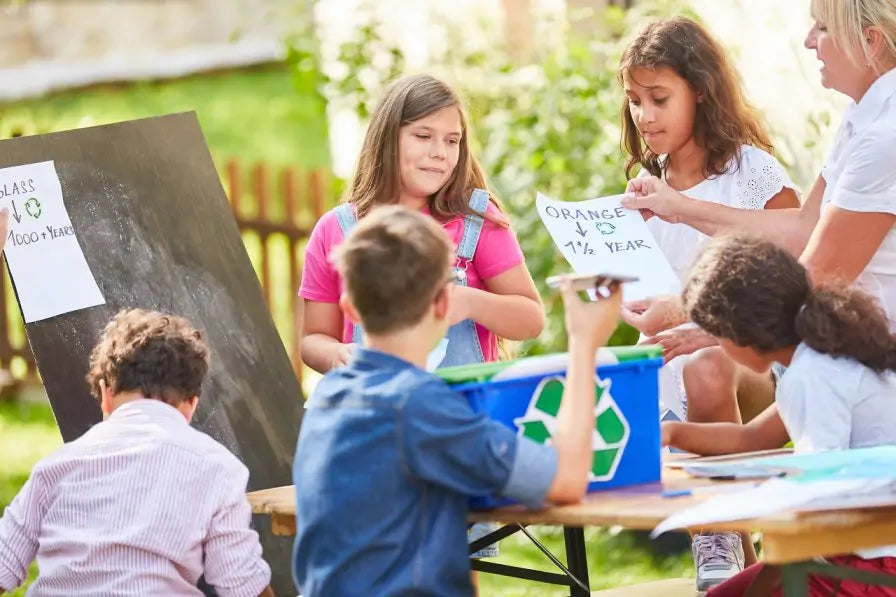Your basket is currently empty.
Shop NowRecycling & Green Projects for School Students – Fun Ideas to Motivate Kids to Go Green

Recycling & Green Projects for School Students
Getting kids involved in the process of recycling is important. The earlier they are aware of the concept and the benefits of recycling, the more likely they are to carry the habit into adulthood.
Teachers and parents alike can help get kids started with these fun projects that will provide hours of challenge, fun, and direct experience with the process of recycling.
Not only will they learn about the concept and actual process involved in recycling, but they will also learn invaluable lessons in personal responsibility and how they can have a positive impact on their immediate surroundings as well as on the environment and the planet at large.
Children need to understand the concept of green living, not just as it applies to rubbish collection and recycling, but also how they can protect themselves and others, as well as the environment, by selecting green products. This applies to everything from insecticides and gardening compounds to personal hygiene and household cleaning products.

Teaching Children Responsibility Early
Children should be taught the difference between harsh chemical compounds and environment-friendly green products at an early age. After a discussion about the differences in these kinds of products, pass out magazines or store advertisements that feature both harsh and green products.
Have them clip out and paste products on an appropriately labelled sheets of construction paper. One page should be labelled GREEN and the other, HARSH. After the cutting and pasting, let each child explain the choices they made and why.
For older students, have them bring in a green product and discuss how it compares to its harsh counterpart. If this is not practical (some schools now prohibit the introduction of most 'chemical' agents) then have the students research a number of green products and their harsh counterpart and prepare a brief comparative analysis of the listed ingredients. The analysis should focus on how the green product ingredients are environment-friendly.
When discussing this topic, especially with younger students, bear in mind that some people may not be able to afford the typically more expensive natural products. Others may not be followers of the green movement. Discussions should never pit child against child or child against parent. It should be presented that green living can be a healthier, better choice. Making it out to be the 'right' choice can alienate students, parents and lead to claims of indoctrination.
Before Earth Day, Arbor Day was celebrated in schools around the globe. Trees were planted on campuses and the kids learned how planting trees was imperative to renew our natural resources and providing vital oxygen to the planet. The first Arbor Day celebration was April 10, 1872. It has been estimated that approximately one million trees were planted on that date.
Students with access to the internet can visit the website www.natureexplore.org for a plethora of educational and family resources for kids of all ages.
School Tree Planting
A school tree planting or garden growing project can raise the children's awareness of the importance of agriculture and protection of green, natural spaces throughout the community.
Learning and planting will bring the children closer to the Earth and give them a deeper appreciation for our interdependence with plant life.
While any seeds or bulbs may be used, it is recommended that quick sprouting plants be used. These include Mexican Marigold, Morning Glory, Zinnias, pole beans and radishes. Trees that tend to sprout and grow quickly include the Mimosa, Willow, Crape Myrtle, and Sweet Gum, River Birch and Tulip Tree.
Where planting is not practical, kids can be allowed to draw their favorite plants and trees and then place them around the room to make a panorama of colorful classroom plants.

In-Class Discussions and Competitions
Teachers should conduct an in-class discussion of the use of school recycling bins and how they are the first step in the recycling process. A field trip to a nearby recycling centre would be a nice way for kids to see the next step in the process and acquaint them with visiting such a facility. The class discussion should include the availability of colour-coded recycling bins.
Hand out sheets for younger students with various types of rubbish pictured (or written) on one side of the paper and colour-code recycling bins represented on the other side. The children will then use matching crayons to connect each item of rubbish to the correct colour-coded bins.
When conducting any kind of competition, keep in mind that a great prize for the winner might be a pack of all-natural chewing gum or other green treat. The sooner they taste the goodness of green products, the more likely they are to accept and adopt green living.
